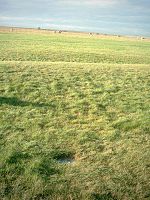Coneybury Anomaly
Archaeological sites in WiltshireSites associated with Stonehenge

The Coneybury Anomaly is a pit with animal and other refuse, interpreted as the remains of a cross-cultural feast, within the Stonehenge Landscape in Wiltshire, England. It was not apparent on the ground and was discovered in the 20th century by geophysical survey. Excavation has produced a large amount of early Neolithic pottery together with a large quantity of animal bone, and flint tools of both Mesolithic and Neolithic types.
Excerpt from the Wikipedia article Coneybury Anomaly (License: CC BY-SA 3.0, Authors, Images).Coneybury Anomaly
A303,
Geographical coordinates (GPS) Address Nearby Places Show on map
Geographical coordinates (GPS)
| Latitude | Longitude |
|---|---|
| N 51.1735 ° | E -1.8093 ° |
Address
Coneybury Henge
A303
SP4 7DD , Amesbury
England, United Kingdom
Open on Google Maps










